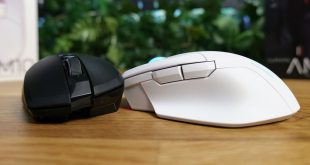Firstly, we are pleased to report that our Roccat Kone XTD mouse worked to its usual standard in the Gigabyte G1.Sniper Z87 motherboard's UEFI BIOS. We tested an NZXT Avatar S mouse which is known for its inability to function in other manufacturers’ BIOS interfaces. The NZXT peripheral worked intermittently with the G1.Sniper Z87.
Upon entering the G1.Sniper Z87 motherboard's UEFI BIOS, users are met with an overwhelming display of voltage, frequency, temperature readouts, as well as a section full of adjustable system parameters.
The main page can be daunting at first sight. Many less-experienced overclockers may be scared away from entering the UEFI BIOS or tweaking its settings due to the quickly-instilled feeling of information overload.
After some practise, the interface does become easier to understand and navigate.
The parameters that are listed in each sub-section are adjustable to a user's preference.
We like Gigabyte's decision to separate many of the adjustable parameters from their related readouts, but the interface's default layout feels muddled on times. Many input and options are repeated in different sub-sections which actually makes tweaking the frequencies and voltages more confusing than it needs to be.
The slider option that Gigabyte installs is unique and works well. Users can easily adjust levels in small increments and be warned by a change of colour when they are approaching dangerous limits.
Fan settings can be accessed via the PC Health Status page. The Manual mode allows the fan speed response with temperature to be set, i.e. the gradient of a temperature against fan speed graph.
Up to eight specific overclocking profiles can be saved to the board. The profiles can be transferred to and from a USB flash drive or other storage device.
Gigabyte has implemented a good-looking, high-resolution BIOS interface on the G1.Sniper Z87. The number of adjustable settings is relevant for the gaming target audience and is unlikely to limit the overclocking potential of connected components.
But the UEFI isn't without its limitations. The default interface seems muddled and is difficult to navigate without practise. Less-experienced overclockers will suggest that the main page suffers from information overload. We also noticed some glitches, such as an instant lock-up when clicking the ‘Performance – Frequency' shortcut, although these are likely related to the early BIOS version that is currently available.
Another point worth noting is that the G1.Sniper Z87's UEFI is heavily reliant upon the use of a mouse. Users with a mouse which does not function with the interface will find BIOS navigation a very difficult procedure, although this isn't entirely the board's fault.
 KitGuru KitGuru.net – Tech News | Hardware News | Hardware Reviews | IOS | Mobile | Gaming | Graphics Cards
KitGuru KitGuru.net – Tech News | Hardware News | Hardware Reviews | IOS | Mobile | Gaming | Graphics Cards















Just ordered it from OCUK – using it for a new build in the new year. good price.
nice colour scheme, nothing I have would match it, so would be quite a change over from my asus board. Gigabyte boards t his year look the best though, no doubt about it.
Its about time these companies put more effort into the onboard audio, so good move gb.
I always really like how they put power and reset switches up close to the memory, they are a godsend when testing things.
I bought this board and its been great – rock solid at 4.4ghz, as I dont like pushing my CPU too high – they run hot. not like ivybridge.
Very well written review, looks like a winner for its price point.
Is anybody intending to buy this board in hope of connecting it to a non galvanic usb dac in order to minimize noise transfer?
Of all the reviews I’ve seen so far, I’ve not seen one that goes into depth regarding the usb dac-up feature yet seem to be concentrating on the performance of onboard sound only.
Hi guys, between this Gigabyte and the Asus Hero, which one is better choice for a gaming rig?